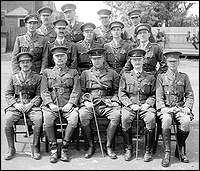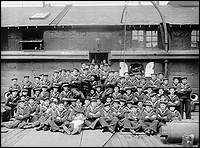|


|

|

Newfoundlanders at War
Newfoundlanders served on land, at sea, in the air and in the nursing services. They served
willingly (no conscripts served overseas), fought hard, and died hard. Nearly 12,000 enlisted in
the three Newfoundland forces—the Newfoundland Regiment, the Royal Naval
Reserve and the Newfoundland Forestry Corps—and the Canadian Expeditionary Force (CEF).
They represented nearly 10 percent of the total male population, or 35.6 percent of young men between the
ages of 19 and 35.
Officers of the First Newfoundland Regiment with British Officers, n.d.
Courtesy of the Provincial Archives of Newfoundland and Labrador (PANL F46-14), St. John’s,
Newfoundland.
 (64 Kb)
(64 Kb)
|
 |

|

|
 |
Royal Naval Reservists, HMS Briton, n.d.
Courtesy of the Provincial Archives of Newfoundland and Labrador (PANL F-37-17), St. John’s,
Newfoundland.
 (55 Kb)
(55 Kb)
|
The initial decision to raise a land force of 500 men was based on the view, widely shared,
that the war would be won on land rather than at sea. The British Army was based on fighting
units (battalions) of 1,080 officers and men, plus reserves of 50 percent, and the pressure to achieve
combat strength proved irresistible.
Assigned to the 88th brigade of the 29th Division, the last infantry division formed during
the war from regular battalions of the British Army, the Newfoundland Regiment distinguished
itself on a number of occasions—Beaumont Hamel, Gueudecourt, Monchy, and Cambrai. Twice it
was nearly annihilated. By the end of the war 6,241 Newfoundlanders (only Newfoundlanders
were eligible) had joined its ranks. An additional 3,296 Newfoundlanders joined the CEF.
At sea, 1,964 Newfoundlanders saw active service in the Royal Naval Reserve. Only
seamen and fishermen were eligible. Naval Reservists were integrated with British forces and
scattered throughout the Navy on literally hundreds of vessels. Unlike the men of the regiment,
they had no opportunity to make a name for themselves as an identifiable Newfoundland fighting
unit, and were consequently overshadowed.
The HMS Calypso, ca. 1910.
The training ship for the Royal Naval Reserve, 1902–1922.
It was renamed the HMS Briton in 1916.
Courtesy of the Provincial Archives of Newfoundland and Labrador (PANL NA-24-68), St. John’s,
Newfoundland.
 (27 Kb)
(27 Kb)
|
 |

|
Also at sea, but not as combatants, were the 505 Newfoundlanders known to have served
in the merchant marine. Of these, 102 died.
Nearly 500 Newfoundlanders, skilled loggers and mill workers, enlisted in the
Newfoundland Forestry Corps. It expressly excluded single young men eligible to enlist in the
fighting forces.
Newfoundlanders at war sustained massive fatality and casualty (dead plus wounded)
rates. Fatalities claimed one quarter of the regiment’s overseas force. Casualties stood at 72
percent, or 58 percent of the nominal roll. Rates for the Royal Naval Reserve were lower. The long-term
effects of the loss of so many young lives, compounded by the number of wounded, disabled
and diseased, were substantial.
Newfoundland women also served overseas in the Voluntary Aid Detachment (VAD),
providing nursing services.

|

|
 |